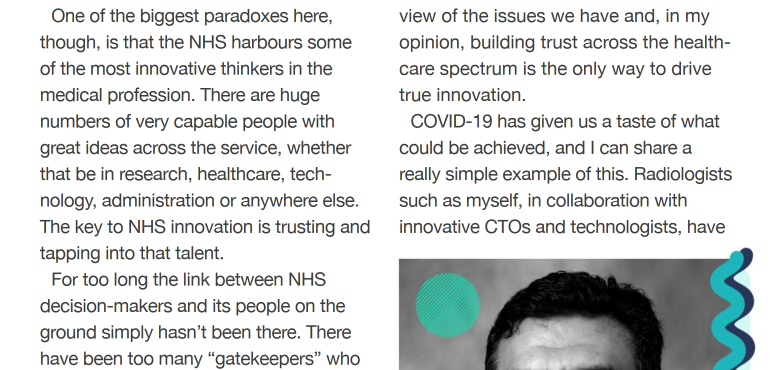Guest blog by Dr Rizwan Malik, Consultant Radiologist, Royal Bolton NHS Foundation Trust & Managing Director SMR Radiology
To provide an effective and efficient clinical service, access to patient data is fundamental. As we touch virtually every clinical specialty, each with its own diverse requirements, radiologists need access to the full range of patient information in order to understand the context of the case and provide the most accurate assessment during the investigation process. But, today, we face myriad obstacles in accessing this data.
The argument for a centralised place for all information pertaining to a patient, accessible to any application and clinician that needs it, at the point of care, is well established across healthcare. We know that the easier the access to all the relevant clinical information a clinician has, the quicker the patient can be treated, if that is the correct course of action.
What’s the situation in radiology today?
While the ubiquitous rollout of Picture Archiving and Communications Systems (PACS) across the NHS as part of the oft-maligned National Programme for IT (NPfIT) can be argued to have met its aim to provide improved operational effectiveness and reduce costs, an unfortunate legacy has been a persisting gap between radiology and other hospital systems, including a disconnect with IT-departments (albeit this is improving).
Despite healthcare’s strategic push to break down data silos, radiology in the NHS is still a PACS and RIS (Radiology Information System) focused world. Competitive forces within the industry traditionally led PACS and RIS suppliers to develop unique, proprietary features that did not always make integration with other hospital applications very easy, impacting interoperability and, therefore, data sharing. It is reassuring to see this landscape is changing within the Radiology space with better adoption of IHE standards and open application programming interfaces (APIs) in the latest products although, unfortunately, the same cannot yet be said for the non-Radiology systems they might look to connect to – if anything, the greater imperative is now for the other hospital systems outside of Radiology to also move to standards-adoption, as well to try to bridge this gap. In addition we need a compelling strategic drive and market forces to overcome the inertia in doing this and compel companies to interact.
In practice, this means that if I receive a request for an investigation, often the only information I have to go on is the request itself – which we all know, in these pressured times, can be fairly rudimentary and lack the detail needed to a) understand the context of the request; b) provide the legal and medical justification for conducting the examination; and/or, c) efficiently perform the investigation. Sometimes it can feel like you are, in effect, on a ‘blind fishing trip’ at the outset.
Is a full patient view really necessary in radiology?
Bluntly, the NHS cannot afford to let the legacy, siloed ways of working continue. If the information that a radiology department needs to effectively conduct an examination is not readily available, but is vital to proceedings, we have a duty of care to the patient to go and find it. In practice, it would often take less time to conduct and report the investigation than track down the information needed to appropriately justify it.
Remember – this isn’t a matter simply of expediency – delays to investigations, from sourcing patient data, impacts care delivery. If you consider NHS England’s new targets for cancer referrals being 28 days from first presentation to the treatment plan being initiated, any delays to scanning, while background medical data is sourced, have a negative impact on the care pathway.
Context is also a very important consideration when reviewing an examination, to understand whether a finding you have identified is of clinical or immediate relevance. For instance, say you are reporting a CT of the abdomen and you notice a small stone in the right kidney; you might feel you have unmasked the cause of the clinical referral which simply said “abdominal pain”; however, if you know that the patient has pain in the lower left side of the abdomen (and nowhere else) you would know this is likely simply an incidental finding, unrelated to why that patient is in pain.
Just enough data for radiology
While we talk about the need to have access to previous investigations and availability of a patient’s full medical picture, there is a point in which too much information starts to have a negative impact on clinician workload and patient care. In the increasingly pressurised NHS, this fear is well-justified and growing.
If we suddenly become deluged with every single piece of information (new and historical) available for a patient, then our duty of care to review all of the information available to us, so that we can provide the very best care, would be an unrealistic obligation to meet. That’s the reason why it is critical that any environment that offers ‘all data pertaining to a patient being available and on one platform, easily accessible’, provides the clinician specific views of that patient data relating to their function and/or the tools to quickly and easily filter the available information.
This is realistic today; but, I can also see a world (in the not too distant future) where the system would intelligently gather and only present the patient information relevant for a case. If it could be relied on, this would certainly increase the efficiency of consulting, diagnosing and treating patients. Certainly, in the Radiology space, modern PACS applications are already attuned to offering up ‘Relevant’ priors for an investigation rather than an unfiltered list of them all, thus potentially masking the ones pertinent to the current examination.
To conclude, clinicians are often frustrated by the lack of patient information available to them at the point of care. It impedes their ability to provide an efficient and effective clinical service. As practising clinicians, we would all benefit from a rich patient history to provide the necessary context by which we can make decisions, formulate diagnoses, create treatment plans, etc. However, that flow of information needs to be controlled as not all clinicians need all patient data. We just need the information that is pertinent to the investigation we are conducting, with the ability to quickly filter out unnecessary noise. This is a very realistic goal that would inordinately assist in the provision of a quality driven clinical service.



